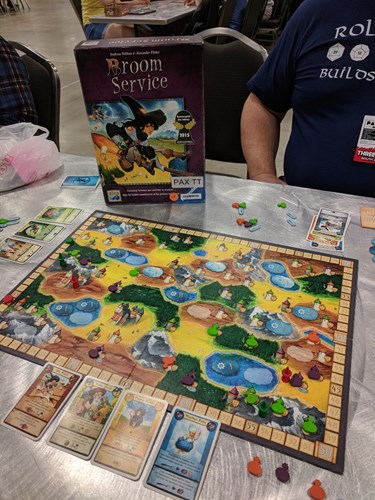
Board @ PAX: Broom Service
Board @ PAX: Broom Service
Welcome to your newest headquarters for all things board game related. This is my first foray into the wonderful world of board game reviews, and as such I expect much to be wrong with this and many people to tell me about it. Oh well, if it means you're reading, then I am winning. And what is a good board game without a clear winner? Well, probably not one worth playing!
So, I hear yourself asking, what is "Board @ PAX" exactly? Is it simply a list of games that Michael enjoys playing? Or possibly just a count of the number of times I was bored while playing games? Well, some might say it's both, but hopefully you'll read this series and realize that you actually need to try (or possibly pass on) a few of these titles. Not everything reviewed will be a winner. Some of them will be downright dreadful games that shouldn't every adorn a game room table. However, this first game is not one of those titles. This first game is one of the best games I played at PAX this year and is a worthy Spiel des Jahres award winner.

Broom Service is a bluffing and hand management game from Ravensburger. The direct successor of Witch's Brew, Broom Service asks a witch to deliver potions to nearby watchtowers crafted from ingredients gathered around the world. But it's not as easy as just delivering potions as you have multiple witches attempting to deliver to the towers as well, and most towers only require one potion before they refuse any further aid. You get victory points for delivering potions, clearing the weather, being brave (which I will discuss further below), and collecting the most sets of ingredients at the end of the game.
First, let me talk to you about the quality of the components used for this game. I'm always a fan of companies that spend just a little more to have quality meeples or tokens in the box, and Broom Service does not disappoint in this manner. While the wands are little pieces of cardboard, the potions you have are all wooden pieces and the witch player tokens are wooden tokens as well. This gives each pawn and most of the game a great tactile feel. I would definitely sleeve the cards for the game so that they stayed nice and rigid, but you can have fun with it and get colored sleeves that match the witches in the game. The artwork by Vincent Dutrait is impeccable and gives the game an easily recognizable fantasy feel.
Now, let's discuss the gameplay. The setup for this game is extremely easy making it a game that you can get out and set up within seconds of deciding to play it. All players around the board start with one of each of the resources available, set their scoring token on the correct place on the scoreboard, place their witches in the starting castles, choose the first witch, and play begins. The gameplay is broken down into two basic phases: the card selection phase and the action phase.
The card selection phase is where you will plan out your action phase of the game. You're given ten cards and asked to select four actions. Three of those cards (gatherer) will create the different resources that you're allowed to acquire, four of those cards (witch) will allow you to move to a different location on the board, two of those cards (druid) will allow you to take a delivery action at your current location, and the last card (fairy) allows you to utilize the weather fairy to remove storm clouds that might be in your way or are just near you. Every player does this part of the game simultaneously and once everyone has selected their cards, play continues on to the action phase of the game.
The action phase of the game has the players declare the actions they wish to take with their cards. This is where the bluffing aspect of the game begins, and where I believe this game really starts to shine. Every action card has a "Brave" action and a "Cowardly" action on it. The Brave action always has an added benefit which can be extra victory points, harvesting extra ingredients, or getting a bonus delivery, but being Brave is inherently risky. A Brave witch, druid, gatherer, or fairy must wait until all of the other players make their actions known before being allowed to take their action. If any other player declares that they are Brave as well, then only the last player to declare as Brave will be allowed to take the Brave action on the card while all other players lose that action entirely. If you are not feeling exceptionally brave about your choice, you can choose to take the Cowardly action. This action is less powerful, but it allows you to take your action immediately and without a player being able to steal your action. Once a Brave or Cowardly action has been declared, going in order around the table, all other players that chose that identical action must declare whether they are brave or cowardly versions as well. This can allow for a player to force an opponent to take an action before they are ready to take that action. Once all of the players who played that action have declared and take their action, the most recent Brave player with cards remaining in hand leads off the next set of action cards. After seven rounds of gameplay, the game score is calculated and the player that accumulated the highest score wins.
This game seems simple at first, but the more you play it, the more you can see the strategies that come into play. As the first player, do you want to try to gather your materials first in the hopes of getting your opponent to play brave and then allow you to be brave on a subsequent action? Do you play a card hoping to guess an opponent's future move before they have the ingredients or positioning to use the card themselves at the risk of using an extra card early? You're constantly trying to figure out if your opponents have played the same card and whether or not you can be brave. I found that having cards in your hand is a powerful tool by itself because the last player to play cards is allowed to be as brave as he or she would like while having an opponent with cards forces a player to consider leading off as cowardly into someone who didn't play the card at all. The action phase is fairly streamlined and doesn't really have any pacing problems. I enjoy the artwork in this game and thematically think this is quite a well put together game.
That being said, there are a couple issues that I have with it. My first issue is that the card selection phase can have definitely pacing issues. A player can have his turn selected and be waiting for his opponents for any amount of time. During that time, there's really nothing going on and there's no interaction with the game at all. During some of the more strenuous decisions, that can lead to multiple minutes going by with one person thinking and one person waiting. Also, I'm not a fan of games that use the same color for a player token and one of the major components of the game. In this game, there is a green witch player token and a herb potion that is green. This is just a personal preference, but with as many colors as are available, it would have been nice to see a white witch token instead of a green one there. It can make it just that much more difficult to read the board at a quick glance when going over your cards. And finally, I do not think this game is very colorblind friendly as the only difference between the different towers that players can deliver to are the colors of the roofs and the only difference between the three potions is the color of the potion. It would have been nice for there to be a subtle difference on each of the tokens and for each of the towers to have a slightly different look for the colorblind.
Despite these mild flaws, the game is still immensely enjoyable and I would give it an overall rating of only 1 out of 5 snoozes. You shouldn't really find yourself being bored while playing this game and I would recommend it to anyone that wants a simple bluffing game with a slight competitiveness that doesn't feel too cutthroat.
Oh, you might be wondering why the score is 1 out of 5 but it sounds like I enjoyed the game. Well, here at Board @ PAX, I wanted to give you a boredom index for the game. One that will accurately reflect just how downright sleepy a game will make you while you play it. So, the more snoozes a game gets, the worse the game is. Got it? No? Eh, I don't really care. I think I'm clever (Editor's Note: he's not), and I'm sticking with it.